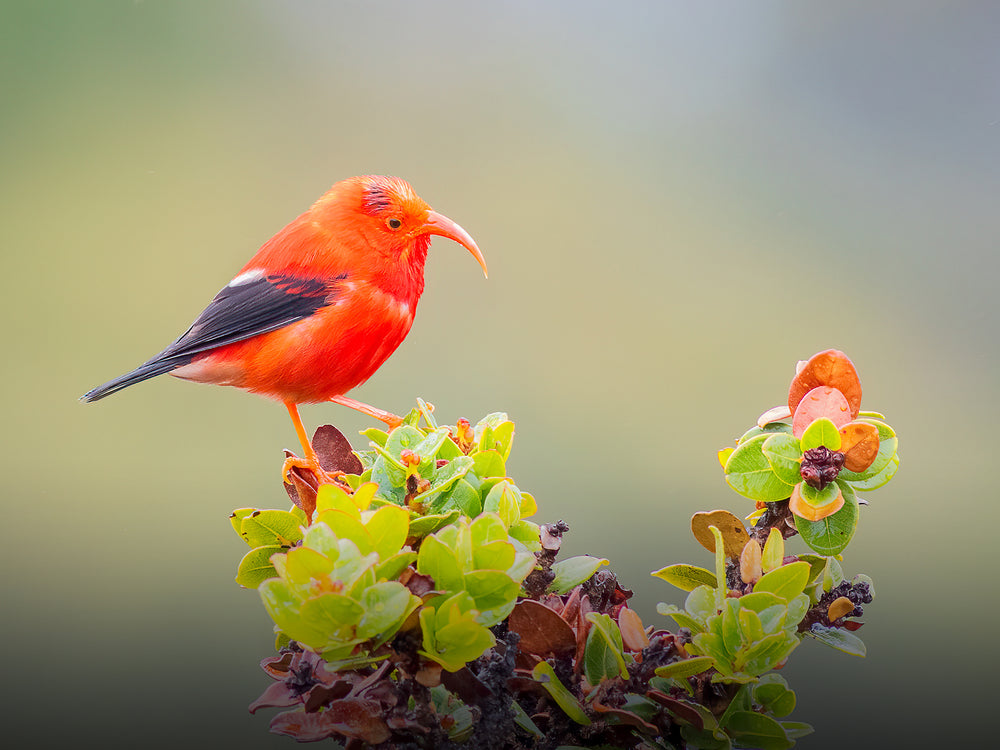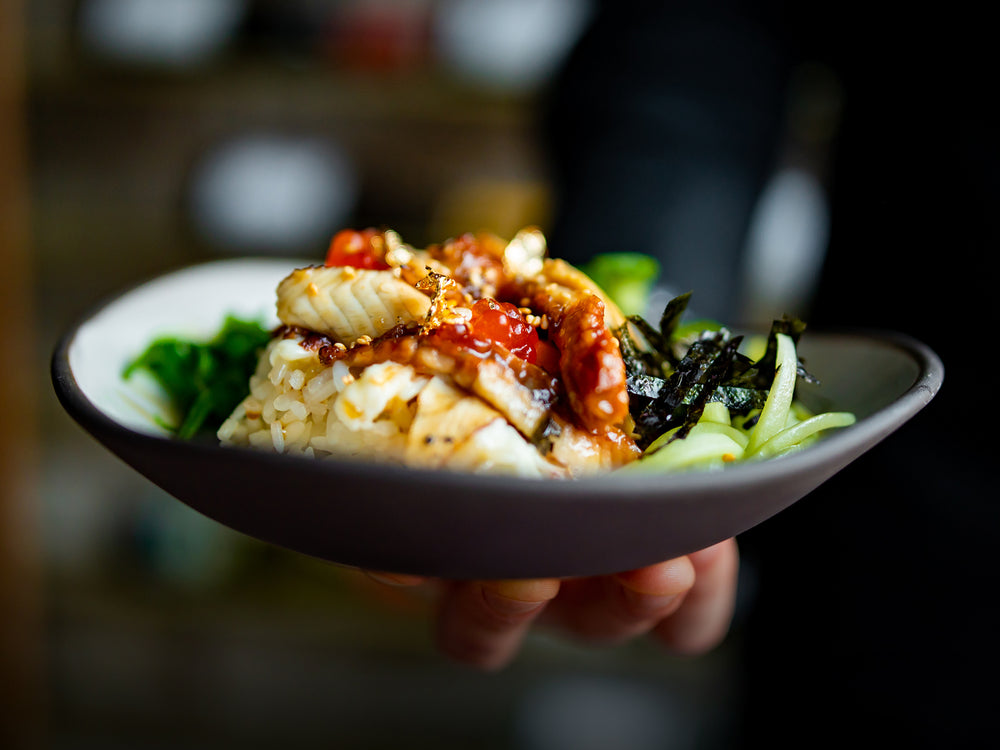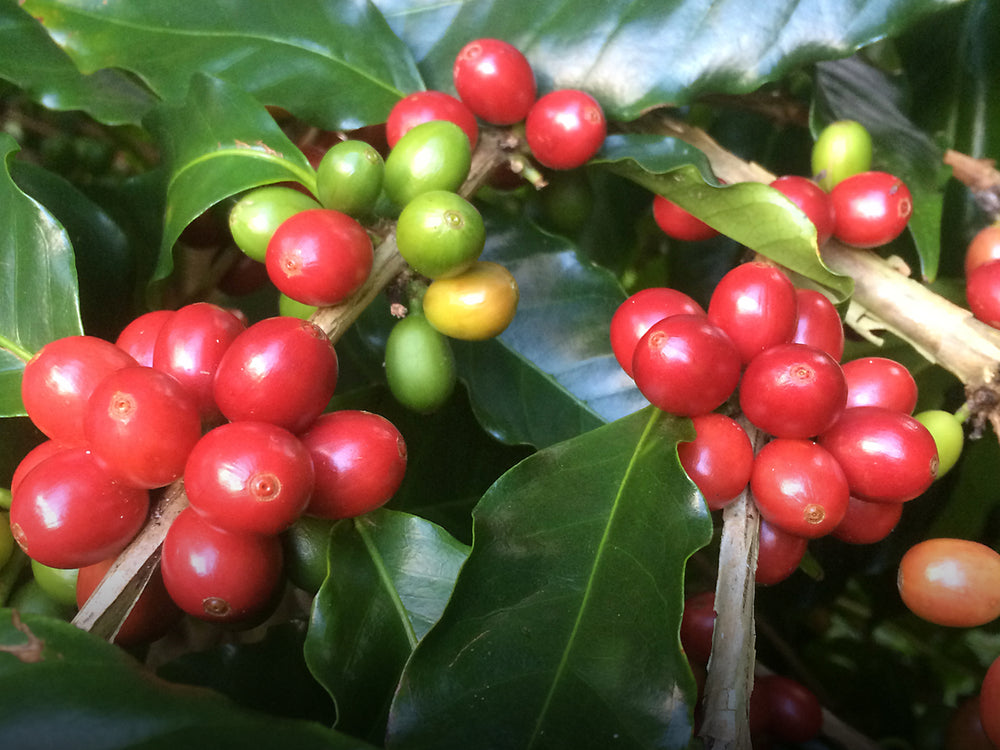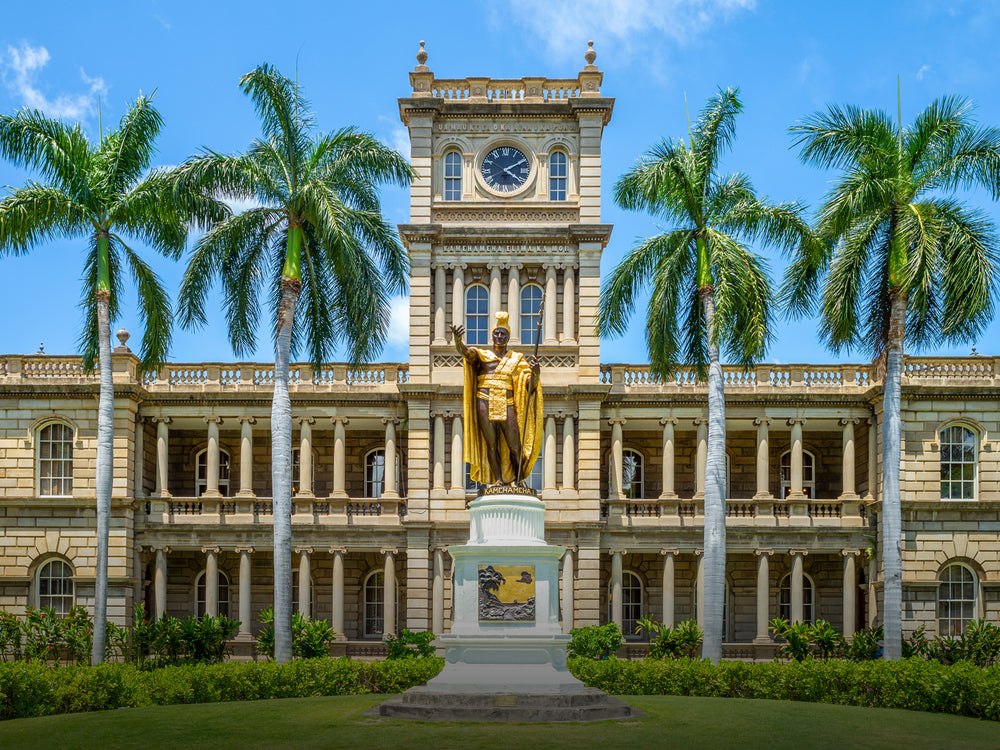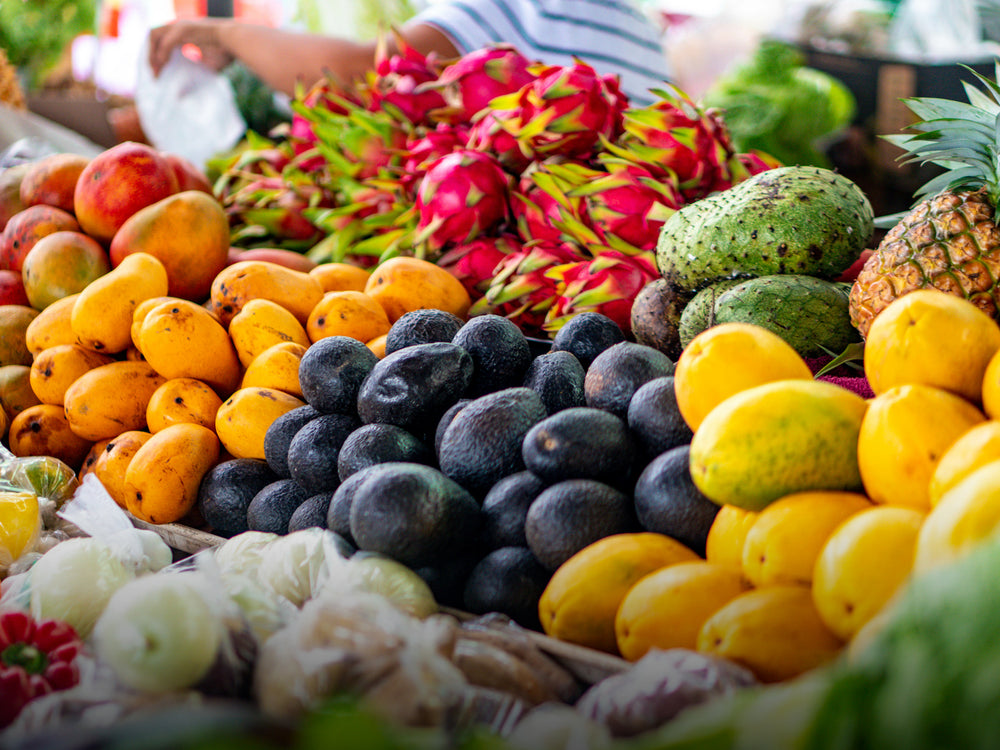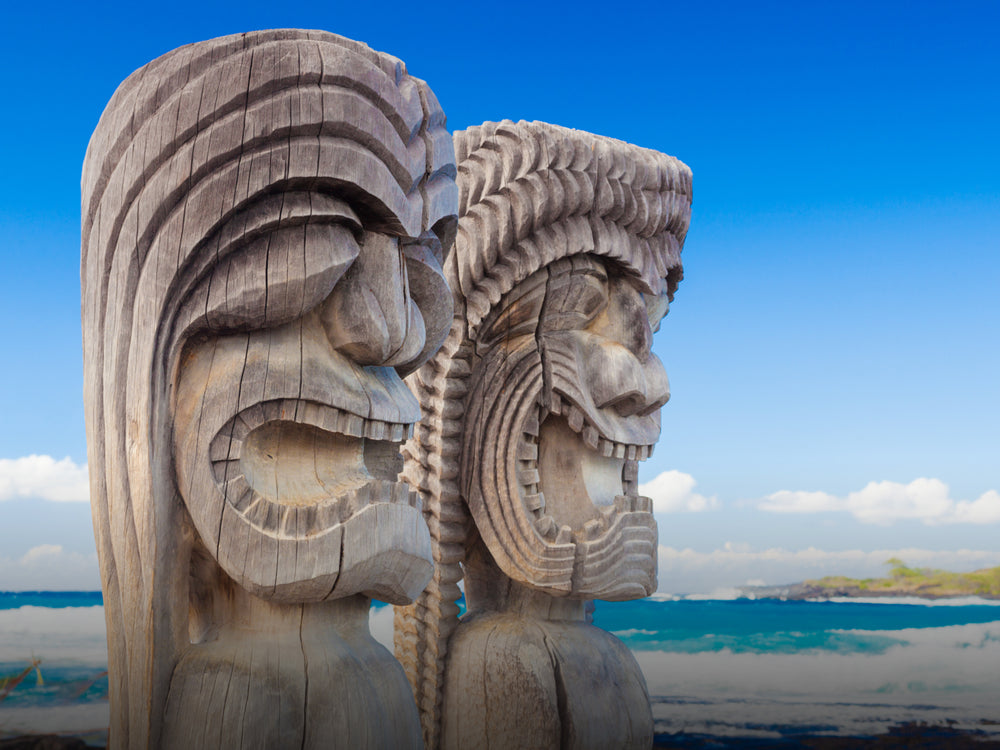A New Way to Prune Coffee?
by Bob Nelson

Coffee orchard pruned in accordance to the Beaumont – Fukunaga Vertical Pruning System using a 3-year rotation. When pruning using the Beaumont – Fukunaga Style Pruning method, the farmer removes all of the verticals from trees in every third row.
Throughout the past 175 years, Kona coffee farmers have tried many innovative techniques in an effort to successfully grow what many profess to be “the best coffee in the world!” Pruning is a necessary technique that is not only required to maintain a healthy tree but keeps quality and quantity at its highest levels.
Traditionally, coffee trees in Kona are pruned using a “Kona Style” pruning method, where each tree supports vertical shoots representing a number of different years. For instance, a tree may support one-year, two-year, three-year, and four-year old verticals. In order to maintain this rotation, the farmer removes the oldest of the verticals found on the tree in late winter or early spring. This removal causes the tree to put out a number of shoots below the cut. The farmer then selects one or more of these new shoots based on size and location and removes the rest. The retained shoots become the newest of the verticals that will bear future coffee.
In the mid 1990’s, the Kona Coffee Council and the UH Cooperative Extension Service held a workshop describing a different pruning technique. Instead of the conventional Kona method described above, this technique is based on having all the verticals on a tree and in a row be the same age with each row being a different age. That is, one row would contain trees with 1-yr-old verticals, another with 2-year olds and a third with 3-yr olds. When looking across the field, you would see a system of 1-2-3, 1-2-3, etc. Each year after the coffee is harvested, all 3-year-old verticals are cut off and the tree can start the following year with all new verticals. Thus the 3-yr-old rows become the next year’s 1’s, last years 1’s become 2’s and last years 2’s become 3’s. My initial reaction to this method of pruning was “WOW, this is the way to prune coffee!” The coffee trees were all standing nice and straight making it very easy to move through the rows to spread fertilizer, control ground cover, pick, and etc. But then I got to thinking; “wait a minute, I have only been involved in coffee farming less than ten years. If this is such a great way to prune and grow coffee, how come everyone isn’t doing this?”
The answer to this question eluded me for some time but finally I came up with what I considered might be a likely answer. Many of the local coffee farmers are from families who have been coffee farming for several generations and generally speaking, farmers are very traditional people. “My dad and his dad before him pruned their coffee using the Kona Style and, since the wheel is not broken so to speak, this is the way I prune my coffee trees!” To some, it didn’t seem logical to cut off perfectly healthy and productive verticals, especially since you wouldn’t be getting any coffee from that tree the following year.
Using the Beaumont - Fukunaga style of pruning has brought us one step closer to producing that ultimate cup of 100% Kona Coffee!
So, is this a radically new technique being used by only a few farmers in Kona? No, not really. It turns out this system was developed in the 1940s and 1950s at the University of Hawaii Kona Agricultural Research Station in Kainaliu by John Beaumont and Edward T. Fukunaga. So what is the name of this system? You guessed it. It’s called the Beaumont-Fukunaga Vertical Pruning System*. From the beginning records show the system never really became popular throughout the Kona coffee belt, but it became widely used in Central and South America. Recently however, a number of farms in Kona have begun using this system or abbreviated versions of it. The growth in its popularity is due in part to the move away from family-worked farms to farms hiring others to do the pruning and labor.
Now that I have convinced myself that this was the way to prune coffee, where and how do I start to implement this system? Our 3.8-acre farm, Lehuula Farms, is centrally located within the Kona Coffee Belt and has supported some form of agriculture for thousands of years. Coffee was first planted here in the early 1900’s but the farm was abandoned sometime around the beginning of WWII. It remained in a rather “wild state” until the early 1980’s when a couple bought it with the intention of turning it back into a working coffee farm. They soon realized this task was more than they had bargained for and put the property up for sale in 1984. My wife and I purchased the land in the spring of 1986 and began the arduous task of finishing the clearing process.
When we made the decision to go from the conventional method of pruning to the Beaumont - Fukunaga method, there were approximately 2,000 coffee trees on the farm ranging in age from 1 year to 80 + years old. In many cases rows were non-existent and the first major task we faced was to establish rows. We did this using a brightly colored line and a can of marking paint. Once the rows and the trees within the rows were marked, we removed the extra trees. Now that we had rows, we were ready to implement the system by stumping (cutting off at approximately 2’ in height) all of the trees in every third row. In addition, we planted numerous young trees (keiki’s) between the existing trees. Since we were using a 3-year rotation, the task of cutting and planting continued for the next 2 years. When we finished after the 3rd year, not only had we converted our farm from a place where coffee trees haphazardly grew to one where the trees were in rows but, we now had approximately 4,000 trees.
Based on our experience at Lehuula Farms, we think there are quite a few reasons why this is an ideal way to prune and grow coffee.
Sunlight plays a very important role in the health and stability of a coffee tree. Under the conventional Kona-style pruning system, young verticals grow in the shade of at least 3 other more mature verticals. Because of this, they tend at times to be rather spindly. When they’re heavy with fruit in their 3rd or 4th years, they cannot support themselves and the orchard becomes a jungle of drooping branches! In contrast, older verticals do not shade verticals grown using the Beaumont- Fukunaga pruning system and thus most become strong and remain standing when mature. The farmer saves a lot of time by not having to go around the farm propping verticals.
Pruning under the conventional system requires the farmer to pay attention to which vertical or verticals should be removed. Under the Beaumont - Fukunaga system, it is a “no brainier” so to speak as you simply remove all of the verticals from those trees in the appropriate rows. This type of pruning allows a lot of extra light into the rows. Since light availability is one of the controlling factors in determining tree spacing, the trees can now be planted significantly closer together. On our farm, this equates to twice as many trees per acre.
Studies demonstrate that coffee production drops off dramatically on verticals older than 3 years. It therefore makes sense to remove those verticals and allow them to be replaced with younger ones. The Beaumont - Fukunaga system actually increases coffee production over time because, even though you’re pruning away 1/3 of your crop each year, you have significantly more trees per acre with healthy and productive verticals.
Shoot selection under the conventional pruning method requires a visit to each tree on your farm 3 or more times per year. With the Beaumont - Fukunaga method, you visit every 3rd, row (only 1/3 of your trees) annually. When the shoots are approximately 12” tall, you go through and remove all but the healthiest 6 to 8 shoots paying close attention not only to size but also position on the stump as well. About 6 weeks later, you revisit those stumps and remove all but the final 4 which will become the new fruit bearing verticals. In the spring, you also have to remove a few shoots from the plants you pruned the previous year.
Since the pruned trees grow and remain straight, the rows remain open. This makes tasks such as picking, ground cover control, and fertilizing much easier. I also feel this system is healthier for the plant. Coffee is a heavy producer, and by using the Beaumont - Fukunaga system of pruning you give the plant a break from producing fruit once every third year. During the year that you stump, all that plant has to do is concentrate on growing healthy verticals.
A lot of people grow and produce Kona Coffee, but there is a difference between doing it and doing it well. Using the Beaumont - Fukunaga style of pruning has brought us one step closer to producing that ultimate cup of 100% Kona Coffee!
* This pruning system actually has three variations: the four year/four row 1-3-2-4, the three year/three row 1-2-3, and the five year/five row 1-3-5-2-4.
Bob Nelson, a farm boy from the mid-west, went to Alaska in the mid-1960's where he attended the University of Alaska and graduated with a BS degree in Wildlife Biology. After a successful career as a wildlife biologist with the Alaska Department of Fish and Game, he and his wife moved to Hawaii in 1994 and became full time coffee farmers. For more information about Lehuula Farms and their superb 100% Kona coffee check out their web site at: www.lehuulafarms.com.
Readers may submit editorial comments to any of our stories by sending an email to les@lbdcoffee.com. We would be happy to attach your comments and feedback to anything we publish online. Thank you for your interest.
Story appeared originally in Coffee Times print magazine and appears online for archival purposes only. Any use or reprinting of these stories without the expressed written consent of the author is prohibited.



